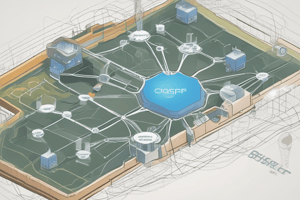Podcast
Questions and Answers
What is the OSPFv2 administrative distance noted in the content?
What is the OSPFv2 administrative distance noted in the content?
- 120
- 110 (correct)
- 90
- 100
How many interfaces are explicitly configured to advertise OSPF routes in the given router?
How many interfaces are explicitly configured to advertise OSPF routes in the given router?
- 2
- 4
- 1
- 3 (correct)
Which command provides the OSPF process information including the router ID?
Which command provides the OSPF process information including the router ID?
- show ip route
- show ip ospf (correct)
- show ospf interface
- show ip protocols
What is the maximum number of equal-cost paths allowed in this router's OSPF configuration?
What is the maximum number of equal-cost paths allowed in this router's OSPF configuration?
What does the command output indicate about the area defined as BACKBONE(0)?
What does the command output indicate about the area defined as BACKBONE(0)?
What occurs when the link between R1 and R2 fails?
What occurs when the link between R1 and R2 fails?
What is the default interval for OSPFv2 Hello packets on multiaccess networks?
What is the default interval for OSPFv2 Hello packets on multiaccess networks?
What happens if a router does not receive a Hello packet within the Dead interval?
What happens if a router does not receive a Hello packet within the Dead interval?
What is the relationship between the Hello interval and Dead interval in OSPFv2?
What is the relationship between the Hello interval and Dead interval in OSPFv2?
Which multicast address is used by OSPFv2 for Hello packets?
Which multicast address is used by OSPFv2 for Hello packets?
What is the cost value for R1 reaching the 10.1.1.4/30 network via R3?
What is the cost value for R1 reaching the 10.1.1.4/30 network via R3?
How often are Hello packets sent on point-to-point networks by default?
How often are Hello packets sent on point-to-point networks by default?
Which command is primarily used to verify that the desired interfaces are active with the correct IP addressing?
Which command is primarily used to verify that the desired interfaces are active with the correct IP addressing?
What does the command 'show ip ospf neighbor' verify?
What does the command 'show ip ospf neighbor' verify?
What happens to the link-state database if a neighbor is declared down?
What happens to the link-state database if a neighbor is declared down?
What command would prevent a router from sending Hello packets?
What command would prevent a router from sending Hello packets?
What indicates that two routers have successfully formed an OSPFv2 adjacency?
What indicates that two routers have successfully formed an OSPFv2 adjacency?
What happens to the routing table on R1 when the link with R2 is shut down?
What happens to the routing table on R1 when the link with R2 is shut down?
Which command would you use to check the routing table for expected routes after configuring OSPFv2?
Which command would you use to check the routing table for expected routes after configuring OSPFv2?
If a router ID from a neighboring router is not visible in the OSPF neighbor command output, what does this suggest?
If a router ID from a neighboring router is not visible in the OSPF neighbor command output, what does this suggest?
Which command provides detailed information about the OSPF routing process itself?
Which command provides detailed information about the OSPF routing process itself?
What would be an appropriate next step if 'show ip ospf neighbor' does not show a FULL state for a neighboring router?
What would be an appropriate next step if 'show ip ospf neighbor' does not show a FULL state for a neighboring router?
Which command will NOT help in verifying that OSPF is functioning correctly?
Which command will NOT help in verifying that OSPF is functioning correctly?
What is the purpose of the 'show ip protocols' command?
What is the purpose of the 'show ip protocols' command?
In the OSPFv2 routing protocol, what is a common consequence of incorrectly configured IP addressing?
In the OSPFv2 routing protocol, what is a common consequence of incorrectly configured IP addressing?
What is the purpose of the Designated Router (DR) in a multiaccess OSPF network?
What is the purpose of the Designated Router (DR) in a multiaccess OSPF network?
Why is a Backup Designated Router (BDR) necessary in a multiaccess OSPF network?
Why is a Backup Designated Router (BDR) necessary in a multiaccess OSPF network?
What multicast address does the Designated Router (DR) use to communicate in OSPF?
What multicast address does the Designated Router (DR) use to communicate in OSPF?
What happens to the status of routers if the DR in a multiaccess OSPF network fails?
What happens to the status of routers if the DR in a multiaccess OSPF network fails?
How is a router classified if it is neither the DR nor the BDR?
How is a router classified if it is neither the DR nor the BDR?
Which command is used to configure passive interfaces in OSPF?
Which command is used to configure passive interfaces in OSPF?
What is the primary role of the network command in OSPF configuration?
What is the primary role of the network command in OSPF configuration?
What wildcard mask is typically used for multiaccess OSPF configurations?
What wildcard mask is typically used for multiaccess OSPF configurations?
What does a two-way adjacency indicate between non-DR and non-BDR routers?
What does a two-way adjacency indicate between non-DR and non-BDR routers?
Which factor will NOT prevent two routers from forming an OSPFv2 adjacency?
Which factor will NOT prevent two routers from forming an OSPFv2 adjacency?
What is the significance of the command 'show ip protocols' in OSPF?
What is the significance of the command 'show ip protocols' in OSPF?
What is indicated by a router's output showing 'FULL/ -' state in the neighbor table?
What is indicated by a router's output showing 'FULL/ -' state in the neighbor table?
Which of the following is a reason for OSPF routers not to communicate?
Which of the following is a reason for OSPF routers not to communicate?
What must be true for routers to successfully establish OSPF adjacency?
What must be true for routers to successfully establish OSPF adjacency?
Which command can be used to verify neighbor status in OSPF?
Which command can be used to verify neighbor status in OSPF?
What will the 'Dead Time' indicate in the OSPF neighbor table output?
What will the 'Dead Time' indicate in the OSPF neighbor table output?
Which OSPF configuration issue may lead to a router not receiving updates from its neighbors?
Which OSPF configuration issue may lead to a router not receiving updates from its neighbors?
When does the OSPF neighbor state transition from 'INIT' to '2-WAY'?
When does the OSPF neighbor state transition from 'INIT' to '2-WAY'?
Flashcards are hidden until you start studying
Study Notes
Point-to-Point OSPF Networks
- Configure router IDs explicitly.
- Use subnet mask to set the network command on R1 and quad-zero wildcard mask on R2.
- Implement
ip ospfinterface command on R3 and configure passive interfaces. - Use
show ip protocolsandshow ip routeto verify OSPF operations.
Multiaccess OSPF Networks
- Multiaccess OSPF networks involve one router that manages LSAs distribution.
- The network administrator should configure the elected router role.
OSPF Designated Router (DR)
- In multiaccess networks, a DR and BDR are elected for LSA management.
- The DR collects and distributes LSAs using multicast address 224.0.0.5.
- BDR passively listens and assumes DR role if the DR fails, while other routers become DROTHER.
Failover Simulation
- Simulate link failure between R1 and R2 by shutting down Gigabit Ethernet 0/0/0.
- Verify routing updates to R3 as the next-hop router with a cost of 50.
Hello Packet Intervals
- OSPFv2 Hello packets are sent every 10 seconds to all OSPF routers (224.0.0.5).
- Passive interfaces do not transmit Hello packets.
- Dead interval defaults to 40 seconds (four times the Hello interval) for neighbor detection.
Default Route Propagation
- Complete Packet Tracer task to propagate a default route in OSPFv2 and verify connectivity.
Verify Single-Area OSPFv2
- Use
show ip interface briefto check active interfaces and IP addresses. - Utilize
show ip routeto confirm expected routes in the routing table. - Additional commands for verification include
show ip ospf neighbor,show ip protocols,show ip ospf, andshow ip ospf interface.
Verifying OSPF Neighbors
- Employ
show ip ospf neighborto check adjacency status with neighbors. - Non-FULL states indicate adjacency issues due to mask mismatches, timer differences, or incorrect network commands.
Checking OSPF Protocol Settings
- The
show ip protocolscommand displays OSPF process ID, router ID, and interface details for routing. - Maximum path is typically set to 4, with default administrative distance of 110.
OSPF Process Information
- Utilize the
show ip ospfcommand to view OSPF process ID, router ID, and the number of interfaces in each area. - Check the last execution time of the SPF algorithm and the number of LSAs in the area.
Studying That Suits You
Use AI to generate personalized quizzes and flashcards to suit your learning preferences.




